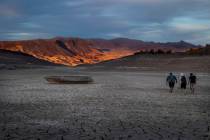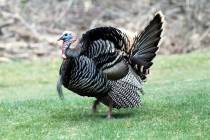Idaho’s inaugural wolf season open to nonresidents
There was a time when you had to travel as far north as Canada to hunt a wolf, but that changed Monday when the Idaho Game & Fish Commission established a harvest limit for the state's first public wolf hunting season. That season is scheduled this fall and is open to nonresident hunters.
"Wolf managers will use the harvest limits the same way (they are) already used effectively with other species that Game and Fish manages. When limits are reached, the season ends,'' according to a statement by the commission.
Hunters will be allowed to harvest a total of 220 wolves from 12 management zones. When the limit in an individual zone is reached, the season is closed in that zone. Hunters will need to report a wolf harvest to the IGFC, and hunters will need to call or check the commission Web site to determine which zones are open. When all zones are closed, the season is over. That's similar to how Nevada manages its mountain lion season.
Idaho's wolf tags will go on sale at 10 a.m. Monday and will be available at all license vendors. A nonresident tag costs $186 and a resident tag only $11.75. Hunters will be allowed to purchase one tag during this inaugural hunt year. Trapping is not permitted, and hunters are limited to firearms approved for the taking of other big game. The use of bait, including dogs and electronic calls, is prohibited.
This opportunity could offer a real challenge for seasoned coyote hunters. While the average coyote stands between 16 and 20 inches high at the shoulder and weighs from 20 to 35 pounds, wolves can be as tall as 34 inches and weigh 120 pounds.
By the 1930s, Idaho's wolf population had been all but extirpated. In 1974, wolves were declared an endangered species. Then in 1995 and 1996, as part of a federal recovery effort, the U.S. Fish & Wildlife Service released 35 wolves in central Idaho. Their numbers have steadily grown. Estimates place Idaho's current wolf population at more than 1,000, with a growth rate of 20 percent a year. If wolves continue to reproduce at that pace, the population could reach nearly 6,200 animals in 10 years.
Naturally, limiting factors in the environment, including the availability of prey species such as deer, elk or moose, eventually would limit that growth. However, the impact of so many large predators on available prey species, as well as on domestic livestock, in Idaho and the surrounding states could be significant. The habitat isn't what it was 200 years ago.
The IGFC wrote: ''Fish and Game has a responsibility to manage those wolves in balance with their prey and their habitat -- just as the agency manages other fish and wildlife species. As with other species, hunting seasons on wolves would be part of managing the population. A wolf hunting season gives Idaho Fish and Game an opportunity to learn how public hunting fits into managing wolves. As Fish and Game learns how effective regulated hunting is, seasons can be adjusted in areas where wolves are causing unacceptable problems for big game herds or domestic livestock.''
While I am unaware of any official wolf sightings in Nevada, that doesn't mean they aren't here. An older gentleman who hunts coyotes in Elko County told me he has seen wolves several times on his forays there. He promised to bring me a photo when he can. There is no wolf season in Nevada, but if you want to give it a try, all you have to do is drive north.
Freelance writer Doug Nielsen is a conservation educator for the Nevada Department of Wildlife. His "In the Outdoors" column, published Thursday in the Las Vegas Review-Journal, is not affiliated with or endorsed by the NDOW. Any opinions he states in his column are his own. He can be reached at dougnielsen@att.net.

















